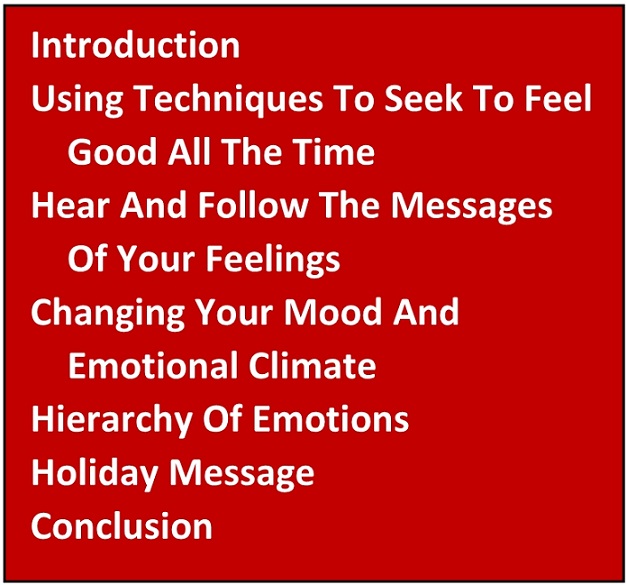Emotions And Feelings (V): Techniques For Working With Our Emotions And Feelings Part (II)
INTRODUCTION
We want to keep our foundational ideas in mind as we explore techniques for working with our emotions. We define emotions as a combination of feelings and thoughts. We generally don’t experience our emotions directly, but rather feel our feelings. We can be aware of our thoughts. The intensity of our experience is determined by the intensity of our feeling and the intensity and clarity of our awareness of our feeling. Awareness of our thoughts comes when we reflect, when we think about our thoughts.
The purpose of exploring techniques is to accomplish change, to change our emotions and feelings to enhance our life. There is short term and long term change. Short term change occurs when we change what we are feeling in the present moment. Long term change involves resolution to our issues—the problems that we have that have deep meaning.
Point Of Empowerment: Let’s remember the challenge for your growth as a reference point and guideline as we go forward. The challenge is to: think about every thought; seek to feel good all the time; and give and receive only love.
USING TECHNIQUES TO SEEK TO FEEL GOOD ALL THE TIME
Remember we cannot and should not feel good all the time, but in seeking and pursuing good feeling we will have many more good feelings during our lifetime. What approaches (techniques) should we use in our seeking? What should our practice be? Here are some suggestions.
- Hear the messages of your feelings. Don’t ignore them.
- Change your feelings of the present moment, change your mood and your inner emotional climate.
- Use the hierarchy of emotion as a guideline for direction and goals.
Practice: After you have heard the message of a feeling, make an immediate shift to your emotional state trying not to get stuck in pain and discomfort. Shift your focus of attention to shift your emotional state. If the feeling is so intense that you cannot hear to message, first change it then understand the message of the feeling.
HEAR AND FOLLOW THE MESSAGES OF YOUR FEELINGS
We have discussed many of the positive aspects of feeling and many of the difficulties we have experiencing our feelings. It is hard to overemphasize the importance of our feelings as guides to living the best life we can.
In the October 2020 Letter we explored identifying feelings and getting the message of a feeling. Please read that Letter if you haven’t read it because you will see how much essential information is contained in our feeling and in the messages of our feeling. (https://iifsd.org/library/newsletters/october-2020-letter/)
We have seen that the messages guide us to take specific actions to either end the pain/painful feelings that we have or to increase the pleasure/pleasurable feelings that are available to us. In this discussion we talked about changing the situations of our life that are external to us. However, there are feelings that arise in response to what occurs inside us, our internal processes. Addressing our internal processes can be a complex task that occurs as we accomplish person growth over the course of a lifetime. When we explore thoughts and thinking in future Letters we will talk about modifying our thinking to change our feelings and emotions.
Point Of Empowerment: The guidance we get from our feelings ranges from the ordinary to the extraordinary, from the routine to the inspired. When we follow that guidance and make the recommended changes in our circumstances, our life experiences change.
CHANGING YOUR MOOD AND EMOTIONAL CLIMATE
In the October Letter we talked about instantly changing painful feelings by changing the focus of your attention. Now let’s recognize that some of our feelings come from the mood that we are in and from our “emotional climate.”
A mood contains a feeling or a combination of feelings that tend to persist longer than ordinary feelings do. We can be in a good or bad mood, an upbeat or down mood, happy or sad, joyous or depressed, hostile or friendly. Moods can be triggered by external or internal events. Moods can be simple or complex depending on the cause of the mood. Simple moods resolve themselves by “just passing.” Complex moods can repeat and persist but can be resolved through personal growth. Complex moods can be part of our temperament and the tendencies that are part of our personality. Our attitudes—our feeling approaches toward life and our emotional climate can give rise to moods.
Practice: You can change a persistent mood by refocusing your attention. Do something our think about something pleasurable.
Our emotional climate is our persistent emotional “weather” comprised of a prevalent group of feelings and automatic emotional reactions to things. Often called our “disposition” it can tend to be “sunny” or “cloudy” for example. To detect your emotional climate, tune into how you are feeling when “nothing much is happening,” and ask, “What am I, how am I, feeling now?”
Let’s see how you we can change a mood or an emotional climate by using the hierarchy of emotion as a reference point and guideline.
HIERARCHY OF EMOTIONS
We introduced the idea that emotions exist in a hierarchy, an order, that ranges from the most pleasurable to the most painful. Our list is a general categorization as there are differences in the way people experience their emotions. As a general guideline, the list is valuable because it can point us in the direction we need to go in to feel more pleasure and less pain. We can see from the list that the emotions and feelings have the same name but remember they are different because the emotion is a combination of feeling and thought. However when we work with the hierarchy we identify the feeling knowing that the emotion is also present. We can change our current emotion/feeling by moving up the hierarchy.
Hierarchy of Emotions
- Hopelessness and despair
- Depression, grief, and powerlessness
- Loneliness and worthlessness
- Hatred and rage
- Jealousy and envy
- Hurt and betrayal
- Fear and anxiety
- Anger and resentment
- Pessimism
- Guilt
- Overwhelm
- Worry and doubt
- Frustration and confusion
- Boredom and impatience
Emotions/Feelings shift here becoming more positive.
- Well-being, contentment, and satisfaction
- Optimism
- Thrill and excitement
- Hope and trust
- Happiness and enthusiasm
- Passion and compassion
- Love and joy
Using Memory to Raise Your Emotional State
Consult the hierarchy of emotion to find the emotion/feeling that you are experiencing at the moment. Locate an emotion within four numbers above. Remember something that would trigger the emotion you have chosen. As you remember, feel the emotion/feeling that you seek to create as intensely as possible. You have now changed the painful emotion/feeling you were experiencing into an emotion that is less painful or more pleasurable. You can continue to work your way up the hierarchy until you have reached an emotion you are satisfied or happy with. For example: I was angry when my spouse was late coming home from work. Then I remembered a situation where I was worried about his/her health. Then I remembered the feeling of wellbeing I had when the health concern was resolved. I have now shifted my feelings from anger to wellbeing.
Using the Future to Raise Your Emotional State
Consult the hierarchy of emotion to find the emotion/feeling that you are experiencing at the moment. Locate an emotion within four numbers above. Pick an emotion/feeling that you want to create. Imagine a situation in the future where you would be feeling it. Immerse yourself in the future that you have imagined and fully feel the feeling.
Point Of Empowerment: Notice how you can use your imagination to change an emotion/feeling.
Using Imagery to Raise Your Emotional State
Consult the hierarchy of emotion to find the emotion/feeling that you are experiencing at the moment. Locate an emotion within four numbers above. Pick an emotion/feeling that you want to create. Use your imagination to generate a desire, a fantasy, a dream, or a plan for a pleasurable situation you want for your future. If we have “something to look forward to” we feel better.
HOLIDAY MESSAGE
During the holiday season we can create happiness and joy for ourselves. Since there is such an emphasis on feeling good during the holiday season, there are many opportunities to experience the good that life has to offer. Here are some suggestions for sources of happiness and joy during the holiday season.
- Spending time with loved ones
- Giving and receiving gifts with gratitude
- Sitting around the fire
- Enjoying a holiday meal
- Laughing together
- Creating the situations that bring you joy.
- Absorbing and experiencing the holiday spirit
- Experiencing the transcendence of the holiday spirit
Also remember to say “no” to unrealistic expectations that others have of you and more importantly, unrealistic expectations that you have of yourself.
CONCLUSION
In this Letter we explored ways to change feelings, emotions, moods, and our emotional climate. Since emotions are also created by our thoughts we will explore thoughts and ways to change them in future Letters. Let’s get excited about understanding and mastering the skills necessary to change, improve, and create the life we want.
